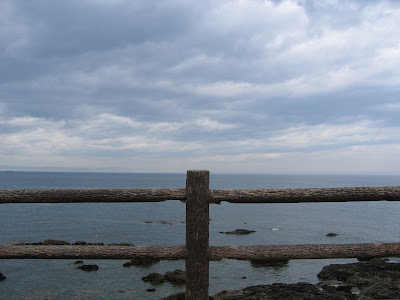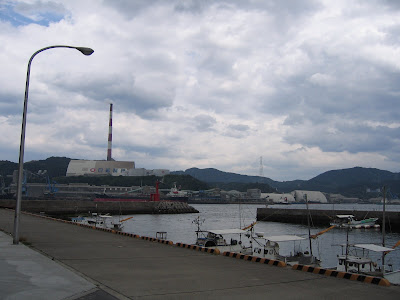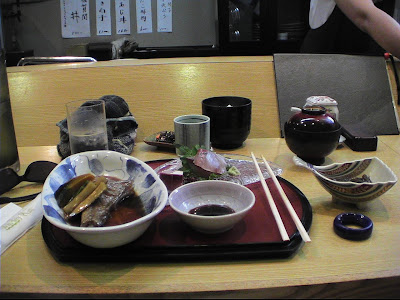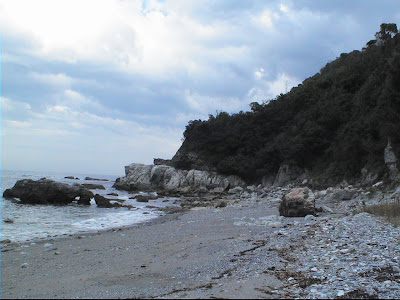Monday, June 22, 2009
It's rainy season in Japan now, and rain was what the weather forecast was.
A Japanese friend and I were talking about whether or not to go to Saganoseki in the rain. "I've gone out sightseeing in the rain before," I said. "It's not a big deal."
My friend was a bit more reluctant. We talked about going to Fukuoka city instead to visit the shopping malls, but in the end we decided to risk it.
The weather was cloudy when we set out for Saganoseki, but it cleared up a bit on the drive down.
Driving through Oita city, we crossed the boarder into Saganoseki.
We followed the main road (197). On our left was the ocean, on our right a cycling road was visible.
When we got to the rest station, we stopped the car and ate breakfast over looking the sea.
The sun was out now and all the colors of the mountains and the ocean were in full view. It was beautiful. We gazed out at the crystal blue ocean, and watched an old man swim from rock to rock. We weren't sure exactly what he was doing, but my friend guessed that he was collecting shellfish from the rocks.
At the beach, a trio of teenage boys were trying to work up the motivation to go for a swim, but apparently the ocean water was still a little bit too cold for them. They were a long time before they finally got in the water, and then they only swam for a short while before retreating back to the land.
I decided to wait to take my pictures until after we had finished breakfast. And just as we were drinking our last cup of coffee, the sky clouded over again, and all the colors disappeared with it. The vibrantly green mountains and blue oceans just assumed a color of gray. "I should have taken my pictures earlier," I said. My friend agreed, but saying this didn't make the sun return, and I had to settle for an overcast look on film.



The whole day would be like this: beautiful one minute, blah the next.
We walked over to the road station ("michi no eki" in Japanese) to try and get some maps or tourist info on Saganoseki.

Surprisingly, they had nothing there.
I say "surprisingly" because these road stations are built for the purpose of increasing tourism in their area. But we poked our head in, and there was nothing there but a small supermarket. When we asked about tourist information, the people there just gave us confused looks and said they didn't have anything. Although later, as we were leaving, one of them did go through the trouble of running out of the building to catch up with us, and give us a guide to Saganoseki restaurants that someone had found in the back of the store.
We also asked about the cycling road, and they confirmed that there was one and that it did go along the main road for a while.
Neither of us had bikes, but I wanted to walk a stretch of the cycling road, and my friend agreed to come along.
There were two sections to the cycling trail: one which went below the main road right next to the ocean, and one which went above the main road. We walked on the latter. It was a pleasant enough walk which took us past several small private gardens and one school. There were lots of flowers along the cycling road, and little bridges at various points where it crossed the main road. To the left was a view of the mountains, and to our right we could look down and see the ocean.





We didn't walk all the way to the end of the cycling road, but we walked for a while until we felt sick of it and then we turned around and headed back.
We got back in the car and drove a little further down the coast. We parked the car again by the ferry port, and got out to walk on another cycling trail (or a different part of the same cycling trail?)
The trail followed the coast line, so we got a good look at the ocean, even though the weather was still gray and cloudy.








After we had stretched our legs here, and I had gotten swarmed by some biting flies (for some reason, they were only attracted to me, and left my friend completely alone) we got back in the car and drove to the Saganoseki Citizens Center. The people at the road station had told us that we could pick up some brochures here, and indeed inside there was a display rack where we stocked up on maps and pamphlets for the city.

It was about lunch time now, and my friend wanted to get something to eat. In fact, the whole reason she had wanted to come to Saganoseki in the first place was to eat some of the delicious fish that this port town was famous for.
"Where do you want to eat?" she asked me.
"Oh I don't know. You choose," I said.
"No, you can choose," she insisted.
"You're the one who wants to sample the local delicacies," I replied. "If it were up to me, I would simply go to Joyfull."
"No, we're not going to Joyfull," she said firmly. "That would be a waste."
She looked through the brochure, and found a place called Yunosuke.
It was not far from the Citizens Center, although it did mean driving through a few narrow alley type streets in downtown Saganoseki before we got there.
Inside was a nice little cozy sushi shop, in which the proprietor skinned and cut the fish right in front of us.
We got a set meal which included rice, fried fish,and sushi.


Despite all my years in Japan, I'm not a big fish fan. I've learned to tolerate sushi over the years because it's boneless and the taste is largely absorbed by the soy sauce and the wasabi. The fried fish I'm not such a big fan of, but I had promised my friend I would try it so I did my best to dig out all the meat from in between those tiny fishbones with my chopsticks.
After we finished lunch, we left the car parked for a while and walked down the street for a while.



At the end of the street was Hayasuhihime Jinja shrine.
According to my Japanese friend, who was able to interpret it for me, this shrine was made because the emperor Jinmu received a sword from an octopus near this spot. (Or something like that. I don't remember all the details exactly).



Once we had looked around the shrine we got back in the car and continued on.
We followed the road 635 as it went out on a peninsula. At one point we there was a scenic overlook, and we stopped at a place called "Kongendori" for a view of the Kansaki area.

At the tip of the peninsula there was a planetarium and a light house.
Neither of us had any interest in visiting the planetarium other than just to see the outside of it. We didn't check the inside for show times.

If you walk around the back of the planetarium, there is a beautiful view of a green hill filled with flowers that slopes down to the light house. The island Takashima is visible in the distance.

I was delighted at the scene and the beautiful walk we had ahead of us. My Japanese friend was a little more far seeing than I was. "If we walk all the way down this hill to the light house, then we'll have to walk all the way back up it on the way back," she worried.

But this was a thought I put out of my mind as I walked down the hill down towards the ocean.
On the way down there was a bell. If you rang it once, it was good luck for those you loved. If you rang it twice, it was good luck for you.
Pretty clever, huh? They make you ring it twice that way. You can't get good luck for yourself without first wishing it on those you loved.
It might be an interesting experiment to reverse the order and see how many people even bother to ring it a second time.
I also wondered where do they get off deciding how good luck is distributed? I could understand if this bell was part of an old shrine whose origins were buried in the mists of time, but it was obviously a newly created tourist attraction. How do they get away with just arbitrarily deciding it is going to give good luck?

Once we had walked all the way down the hill, the actual light house was a little anti-climatic from the walk itself. The light house of course was locked, so we couldn't go inside, but we could walk around it, and there was an overlook of the ocean.



I had never been to Takashima, but my Japanese friend had gone scuba diving off of it's coast once. She told me it was a great place to scuba dive, but nothing much to see on the island itself.
Slightly down from the lighthouse was another series of steps leading all the way down to the beach. My Japanese friend expressed more reservations ("we're going to have to climb all the way up to get back"), but we decided to climb down and check out the beach anyway.
After spending some time at the beach throwing stones in the water, we decided to head up.



At just about that time, it started to rain again.
I took a minute to wrap and double wrap my video and camera in plastic bags, and then wrap them again in a towel and put them in my backpack. With my electronic equipment secured, I was prepared for a leisurely stroll through the rain.
My Japanese friend had other ideas though. We never communicated our thoughts exactly, but she seemed to have a much bigger aversion to getting wet than I did. She sprinted up the hill, taking stops only under the shelter of trees when she needed to catch her breath.
I made an effort to keep up with her at first. She was in much better shape than I was, but my legs were so much longer than hers that my long steps were able to make up for many of her shorter ones.
For a while I was able to keep ahead of her, and then my bad eating habits and lack of exercise caught up with me, and I was just wheezing on the hill. I gave up and returned to leisurely walking in the rain. "You go up ahead of me," I said. "I'll just meet you there."
Eventually we both reached the top. We took shelter under the doorway to the planeterium for a while as we watched the rain.
Once the rain had let up, we went back to the car.
The weather during rainy season is funny. Pouring rain one moment, blistering heat and sunny skies the next. Soon the sun came back out.
We continued driving down the road, and we soon saw signs for Sekizaki Inari Shrine. "Do you want to stop and have a look?" I asked.
"It's up to you," my friend answered, in a voice which clearly meant, "Well, not really."
I was driving though, so I decided to stop. We parked the car in the parking lot, and walked down the path to the shrine.


Soon things began to look familiar, and we realized we were on the same path we had just come from. Sekizaki Inari shrine was a little shrine right next to the light house that we had previously passed by without giving it much thought. (It was so small and plain it seemed odd that it was marked out as a tourist destination by the road signs). So I took a picture, and then we just returned to the parking lot.

Next stop was the Kurogahama beach.
This beach was made up entirely of small black stones. I'm not sure why. How did all of these black stones all end up in the same area? And why were they all so smoothly polished?
I'm sure there's a good geological reason for this, but lacking someone to explain it to us it just seemed like one of the mysteries of nature.
Out in the ocean were two stones jutting up from the water, joined together by a straw rope. The name of the rocks is bishagoe, which, according to my friend, was named after the type of seagulls which were flying around the area.


After spending some time by the beach, we decided we had time to see one more sight. We continued driving along the peninsula along the main road 635.
However what was previously a main road narrowed down to a small one lane dirt trail.
That part happens often enough in the Kyushu countryside. What caught us a little bit more offgaurd was the road went right alongside the ocean.
And I mean right alongside it. There was literally nothing between where the road ended and the ocean began. There was no shoulder or anything. If we would have moved the car even slightly to the left, we would have been right in the ocean.
Now, the road was raised slightly higher than the ocean, but some of the bigger waves were splashing over. Mostly they were just kind of sprinkling the road, but right as we were driving through a huge waved splashed up and doused the whole car.
Fortunately we had the windows shut at the moment, but I had to stop the car for a moment and get the windshield wipers going back and forth a few times until we could see again.
"Well, that's it," said my friend. "I've got to get the car washed now, or the salt water will be bad for the engine."
Being a Mid-Westerner, I never think about things like the effect of ocean water on a car, so it was a good thing my Japanese friend was there. (And it was also her car we were driving).
We decided we must have somehow turned off the main road, and so at the next opportunity we turned the car around and went back.
As it turned out, we had been on the main road after all. Sometimes in the countryside even main roads have really sketchy parts.
Anyway, once we had turned the car around and started heading back, that ended up being the end of the day. We drove back towards Oita city while we looked for a car wash.
I was getting pretty hungry, so we stopped at the Saganoseki Joyfull on the way out.
I know, I'm not very adventerous. No matter what city I go to, I always end up eating at the Joyfull.
Although in the case of Saganoseki, the Joyfull was right next to the ocean, which made it a little bit different than all the other Joyfulls I've been to. The waves lapped right up against the buildings foundations, and from our table we could look out and see nothing but blue water.


Saganoseki Links
Scenic Picture contest,
Panoramio Photos,
Saganoseki Bike Ride
Link of the Day
Interview with Noam Chomsky about the War on Drugs and religion






No comments:
Post a Comment